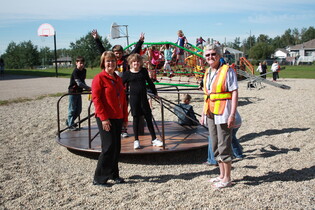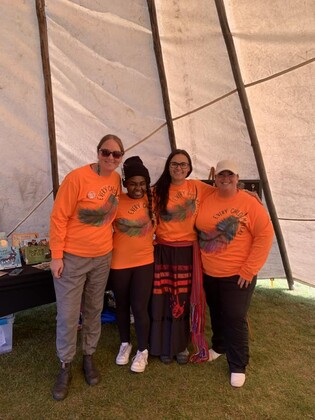
Schools are considered to be one of the safest places in our communities. However, an emergency can strike anywhere and at any time. At Northern Gateway Public Schools, we have several measures and procedures in place to ensure the safety of students, staff and guests. These include:
- a Division Emergency Response Plan and School Emergency Response Plans which work in conjunction with other local support and emergency response agencies within our communities;
- on-site emergency response teams at each school, along with a Division-based Emergency Response team who provide support and aid to schools during an emergency, and
- regular training of all staff on emergency protocols, and drills which are practiced throughout year at each school.
School Emergency Program
Parent Guide - NGPS School Emergency Program
Welcoming, Caring, Respectful and Safe Learning Environments
The following Administrative Procedures support environments that respect diversity and foster a sense of belonging and a positive sense of self.
- Administrative Procedure 361 Appendix 361-1 Code of Conduct
- Administrative Procedure 175, Welcoming, Caring, Respectful and Safe Learning Environment: Inclusive Practices
Bullying
Peer Conflict, Mean Behaviour and Bullying: What's the Difference?
When a child is having a problem with her or his peers, it can be hard for parents to know what is really happening – is it bullying? Or is it something else? Each type of behaviour must be handled differently, to keep children safe and help them learn how to get along with others.
Peer Conflict
Conflict between and among peers is a natural part of growing up. Children will have times when they disagree and can’t solve their own problems. They may even become so frustrated that they say mean things or act out physically by hitting, kicking or trying to hurt.
If it’s peer conflict you will be aware that these children:
- Usually choose to play or hang out together;
- Have equal power (similar age, size, social status, etc.);
- Are equally upset;
- Are both interested in the outcome; and,
- Will be able to work things out with adult help (after calming down).
Adults can respond by helping the children talk it out and see each other’s perspective. This is often referred to as “conflict resolution”.
Mean Behaviour
Children may try out behaviours to assert themselves – sometimes saying or doing mean things – such as making fun of others, using a hurtful name, taking something without permission, leaving a child out, or “budding” in line.
Mean behavior:
- Is not usually planned and seems to happen spontaneously or by chance;
- May be aimed at any child nearby;
- The child being mean may feel badly when an adult points out the harm they’ve caused.
When adults see mean behaviour they should not ignore it. Adults should respond quickly, firmly and respectfully to stop the behaviour, to let kids know that their actions are hurtful and to re-direct children to more positive behaviour.
This quick response stops children from developing a pattern of mean behaviour as their way of interacting with peers, and prevents mean behaviour from escalating into bullying. It is a lot easier to correct a child for one nasty comment than to change a pattern of cruelty that grows over time.

Bullying Behaviour
Bullying is a serious behaviour that has three key features – all three must be present for the situation to be considered bullying:
- Power imbalance - One child clearly has power over the other(s), which may be due to age, size, social status, and so on.
- Intention to harm - The purpose of the bullying behaviour is to harm or hurt other(s) – it’s intended to be mean and is clearly not accidental.
- Repeated over time - bullying behaviour continues over time, and gets worse with repetition. There is a real or implied threat that the behaviour will not stop, and in fact will become even more serious.
The effect on the child who is being bullied is increased fear, apprehension, and distress. Often by the time adults find out about what is happening, the child has tried many ways to stop the bullying but cannot do so on their own.
Adults must address the bullying behaviour and ensure the safety of the student who has been targeted. They also need to reassure the children who may have witnessed the behaviour that adults are taking care of it.
When schools respond to bullying, staff will also help the child who has been bullying others to take responsibility for their actions, and change their behaviour. They will monitor the situation to ensure the bullying stops, and will support the child who has been bullied to regain confidence and a sense of safety. Staff may follow up with the students who observed the behaviour to help them learn what to do when they see bullying.
Toolkit for Supporting Healthy Relationships
We are pleased to share this Toolkit as we continue to promote positive interactions in our schools and communities. We believe that the best way to establish a positive school culture is to focus on the development of healthy interpersonal relationships. We understand that bullying is a relationship problem that requires relationship solutions. This Toolkit has been developed to provide strategies to teach and model social skills, assertiveness, empathy and conflict resolution skills. In addition, it provides our schools with information and tools to promote collective responsibility through systematic, school-wide collaboration.
For more information, please refer to Northern Gateway Public Schools' Administrative Procedures:
Administrative Procedure 736: Harassment
Administrative Procedure 175: Welcoming, Caring, Respectful and Safe Learning Environment: Inclusive Practices
Administrative Procedure 361 Appendix 361-1: Code of Conduct
Violence Threat Risk Assessment (VTRA)
The goal of the Violence/Threat Risk Assessment (VTRA) process is to ensure that every incident of youth violence in our communities is addressed. VTRA is early intervention, which is quite possibly prevention.
As a Division, and in cooperation with other local school divisions, government, RCMP and community partners, NGPS administrators and leadership staff have completed intensive safety training through the Center for Trauma Informed Practices.
Together, we have developed a prevention and intervention protocol to respond to situations in which students may be posing a threat to themselves or others. As always, our goal is to keep our students and schools safe and respond to threats in a proactive and coordinated manner that provides for a healthy and caring learning environment. The Whitecourt & Surrounding Area, Violence Threat Risk Assessment Community Protocol applies to all NGPS school communities.
Whitecourt & Surrounding Area, Violence Threat Risk Assessment Community Protocol
Crisis Hotlines
Most of these services are available 24/7 to both families and individuals in need. Click on the name of each service to learn more about it. Always call 9-1-1 if someone is in immediate danger.
Provincial Abuse Line
If you suspect an Albertan is being abused or neglected and don’t know where to turn for help, call the centralized abuse line. You will be connected to resources, supports, services and referrals to address your concern.
Phone: 1-855-4HELPAB (1-855-443-5722)
Child Abuse Hotline (24/7)
If you have reason to believe a child is being abused or neglected by their parent or guardian, please contact the Child Abuse Hotline to discuss your concerns.
Phone: 1-800-387-KIDS (5437)
Child & Adolescent Mental Health: Crisis Line & Mobile Response Team
Offers support by phone to children and teens during a crisis. Provides these services:
- Assesses children’s needs
- Offers information about community services for children and their families
- Offers support
- Teaches about mental health problems
- Makes referrals to healthcare providers if needed
- Arranges home assessments if needed
- Provides links to follow-up care if needed
- Allows access to a child psychiatrist
Phone: 1-800-387-KIDS (5437)
Canadian Mental Health Association Distress Line (24/7)
We are available to talk anytime – 24 hours a day, 7 days a week, 365 days a year. Crisis doesn’t take time off, so neither do we. When you make a call to the Distress Centre, you will always get an answer, an open mind and a caring ear.
Phone: 780-482-4357
First Nations and Inuit Hope for Wellness Help Line (24/7)
Provides immediate, culturally competent, telephone crisis intervention counselling support for First Nations and Inuit, 24 hours a day, seven days a week. Counsellors can also work with callers to identify follow-up services they can access. Counselling is available in English and French and, upon request, in Cree, Ojibway, and Inuktuk.
Phone: 1-855-242-3310 (Toll Free)

Division Resources
- Fox Creek CHAMP Team Community Helpers and Mentoring Program
The CHAMP Team is a Mental Health Capacity Building Initiative that promotes positive mental health in Fox Creek School and the greater community through a variety of programs. The Team also offers programs and services to Oscar Adolpson Primary School and Harry Gray Elementary School, in Valleyview.
Program Coordinator: Sandra Hardy
Phone: 780.277.0094
Email: sandra.hardy@ngps.ca
- Whitecourt Team for Success
A Mental Health Capacity Building Initiative that promotes positive mental health in Whitecourt schools through a variety of supportive programs.
Team for Success Coordinator: Teagan Arnott
Phone: 780.778.3898
Email: teagan.arnott@ngps.ca
- The CREW
The CREW is our newest Mental Health Capacity Building Team that promotes positive mental health in the communities of Onoway, Alberta Beach, Rich Valley and Darwell.
Program Coordinator: Sandra Hardy
Phone: 780.277.0094
Email: sandra.hardy@ngps.ca
- Tammy Charko, NGPS Social Worker
Our division Social Worker advocates for students and parents and provides a link to local supports.
Phone: 780.778.2800
Toll-free: 1.800.262.8674
Email: tammy.charko@ngps.ca